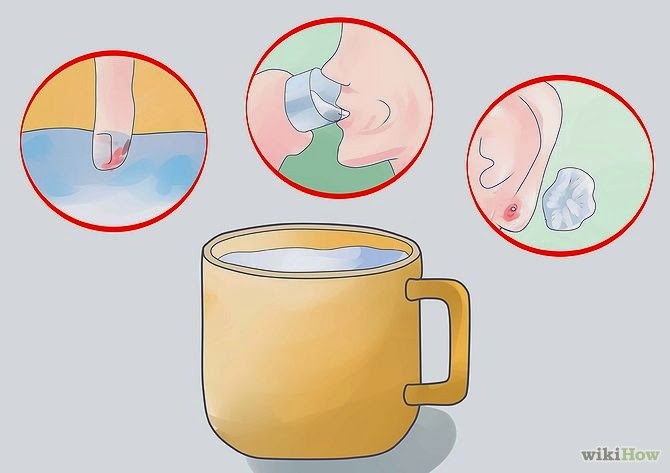Certain factors may increase
your risk of developing a nickel allergy
Having ear or body piercings. Because nickel is common in jewelry, nickel allergy is most often associated with earrings and other body-piercing jewelry containing nickel. If the first jewelry you wear after a piercing contains nickel, your body is constantly exposed to the metal during the healing time. And people who have piercings often wear jewelry every day. The more piercings you have, the greater your risk of developing a nickel allergy.
Source: MayoClinic
Tips for Getting Piercings
1. Work with professionals who
follows local health department guidelines. That is the best way to prevent
infection. Professionals also use procedures to prevent against
the transmission of blood-borne diseases, like tetanus or HIV.
2. Use a properly licensed piercing studio. Your state, county or city health department will have information on licensing requirements for piercing studios.
Avoid DIY piercing. Doing it yourself or having an untrained friend
perform the piercing is unsafe, since you don't have
sterile tools and antiseptic procedures are required to minimize the
chances of infection.
3. Make sure the piercer uses appropriate equipment. Piercers should wash their hands between piercings and wear a fresh pair of protective gloves for each piercing. Avoid ear-piercing guns because they cannot be sterilized properly (unless they use a disposable piercing gun). The jewelry used with piercing guns is relatively blunt, causing unnecessary damage to the piercing. When the wrong type of piercing tool is used, corrosion causes the release of nickel ions, which can leach onto the skin. The same goes for studs used while the ear lobes are healing.
4. Make sure that the piercer sterilizes all non-disposable equipment. Professional piercers use an autoclave (a sterilization machine) to sterilize equipment. Piercers should sterilize larger equipment with a commercial disinfectant or bleach solution after each use.
5. Expect your piercer to use hypoallergenic jewelry. Surgical steel, titanium, niobium or 14 or 18-carat gold are appropriate for a new piercing. Avoid nickel, which commonly causes allergic reactions.
General Treatment After Piercing
Suggested Materials:- Sea Salt
- Mild Anti-Bacterial or Antimicrobial Liquid Soap/Wash (Like Provon or Satin)
- Cotton Balls
- Cotton-tipped Swabs
- Small disposable cups (2-4 ounces)
Cleaning Your Piercing:
1. ALWAYS wash your hands thoroughly. Never touch your piercing or jewelry with dirty hands.
2. Saturate a cotton ball with warm water, and gently wipe away any crusty deposits that have gathered around the piercing site. Throw the cotton ball away.
3. Apply a generous amount of liquid soap to your fingertip, and rub onto the piercing site and jewelry. Make sure you get the soap everywhere. Rotating the jewelry is not necessary as long as you work the soap around the piercing and jewelry completely.
4. Rinse the piercing and jewelry several times with warm water, ensuring that all soap has been removed.
5. Dry your piercing with a clean paper towel and then dispose of it.
Source: About.com - Piercing Aftercare
Other Healing Aids To Use After Piercing:
- Coconut oil (has antibacterial properties)
- Tea Tree Oil/Melaleuca Oil (antibacterial properties)
- Lavender Oil (antibacterial and soothing properties)
- Saline Solution made with Sea Salt (NOT iodized salt)
How to Treat An Infected Piercing
If these symptoms last for 2 or more days, it is probably infected:- Red, inflamed streaks or marks on the skin that radiate out from the piercing site.
- Increased pain, redness, swelling, heat, or tenderness around the piercing site.
- A thick yellow-green pus-like discharge coming from the piercing site. It's normal to see a bit of oozing or bleeding from the piercing which is a sign of healing, but be alert for pus combined with swelling and redness.
- Swollen or tender lymph glands above or below the piercing. With an ear piercing, you may feel sore and swollen glands in your neck around your jawline.
- Fever. If you're otherwise healthy (no cold or flu), and you develop a fever, this is cause for concern.
Infection or Allergic Reaction?
Signs of an allergic reaction versus an infection include burning sensation on the skin, an expanding wound, and a clear yellow discharge.PLEASE NOTE: Once you experience an allergic reaction with a piercing, the allergic reaction will always be a possibility. And each time you expose your piercing to that same allergen, the reaction will increase.
For instance, if you are allergic to nickel, each time you wear jewelry containing nickel, the allergic response will be worse. So the key is to eliminate exposure of the allergen in order to limit allergic responses.
Read about safe metals for piercings here




